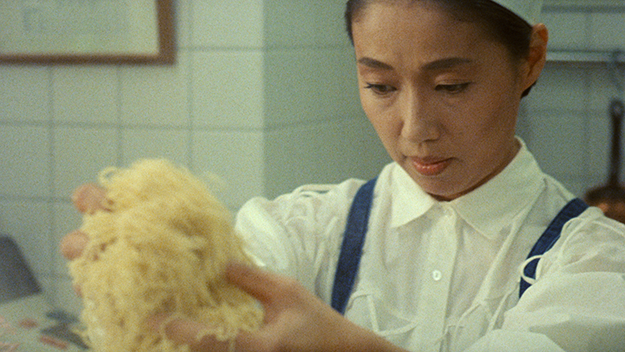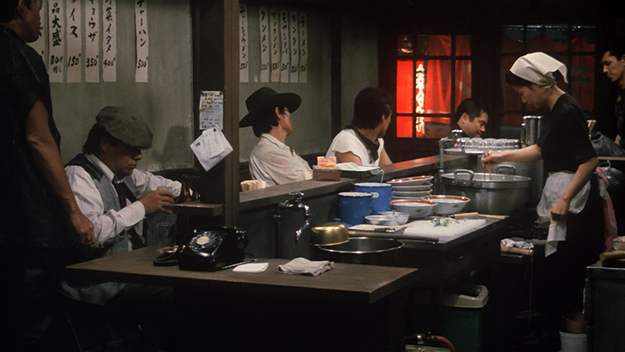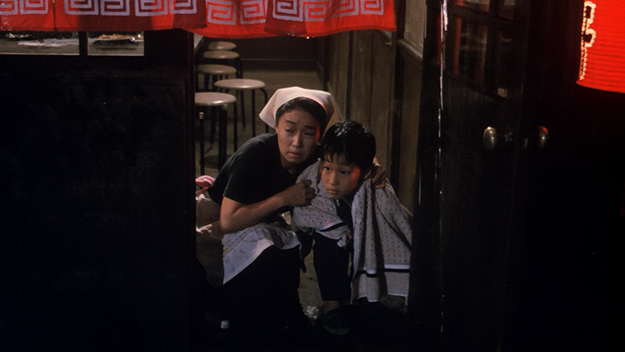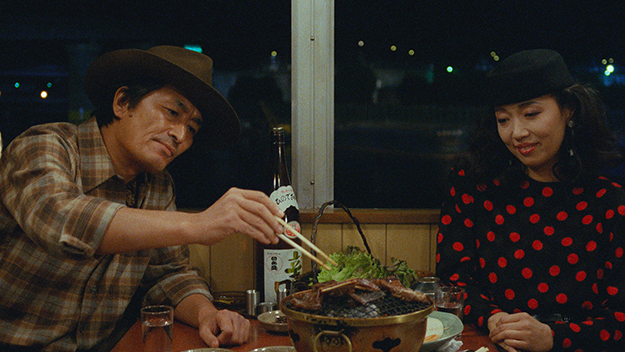Deep Focus: Tampopo

A gleefully sensual and inventive comedy, Tampopo was an art-house smash in 1987. Director Juzo Itami drew on American noirs and gangster films and Westerns and probably comic books, too, to come up with a quintessentially Japanese lark that blissed out audiences around the world. More than wacky and funny, it’s flavorful. If Itami had managed to revive AromaRama or Smell-o-Vision, or had come up with scratch-and-sniff cards to match the scents of soy, onion and wasabi, the movie might never have stopped running. Instead, it fell into neglect—until now. In a new 4K restoration, Tampopo is more vivid and seductive than ever: a garden of sensual delights that plays like a romp through a surreal amusement park.
“Revenge is a dish best served cold,” goes the old Sicilian proverb, but in Tampopo, the story of a plucky widow who learns how to cook and sell the best ramen in Tokyo, revenge is best served in a steaming hot broth, with noodles that are left standing overnight, then rolled three times, and adorned with perfectly cut slivers of pork and scallions. Tampopo, which means “Dandelion,” is the name of the heroine, played by Nobuko Miyamoto (Itami’s wife). Imagine Seven Samurai in 1980s Tokyo, where the goal is not to save peasants from bandits but to avenge insults to Tampopo’s cooking skills and to save her noodle shop from established, high-powered competition. That should give you some idea of this movie’s glorious, revitalizing incongruities. Tampopo, a widow and single mother, claws her way to victory—and to culinary perfection—with the help of an urban cowboy all-night truck driver, Goro (Tsutomu Yamazaki); his sidekick Gun (Ken Watanabe); a contractor with a knack for decoration, Pisuken (Rikiya Yasuoka); a ramen guru so revered he is referred to only as the Master, or Sensei (Yoshi Kato); and Shohei (Kinzo Sakura), a noodle-chef/chauffeur loaned out by a ramen-loving rich old man. If they don’t comprise a magnificent seven, they’re at least a fantastic five.
Itami doesn’t tell Tampopo’s tale straight out. He intermingles it with the erotic gourmet adventures of a white-suited gangster (Koji Yakusho) and his avid, up-for-anything lover (Fukumi Kuroda), part of the free-association riffs on fleshy and foodie pleasures that culminate, in the closing credits, with the camera tenderly closing in on an infant feeding at its mother’s nipple. It’s almost like a game of “Can You Top This?”—except that Tampopo starts outrageous and stays that way, continually tweaking our expectations. Indeed, the opening is one of the movie’s high-points, as the dapper mobster enters a cinema with his moll, then turns to the camera and harangues us about the sounds he most detests in theater— people chomping on potato chips and crinkling wrappers. The gangster has more courtly dining habits: his minions unfold a tasteful white café table in front of him and then unpack a feast. As Tampopo goes on, the gangster makes some slippery moves. He indulges in egg-play with his mistress that could be called the Yolk of Intimacy. He and she move the yellow orb between their mouths until, orgasmically, it bursts. He’s one lucky hedonist: even after he cuts his lip trying to scarf down an oyster straight from its shell, an oyster-diving nymphet feeds it to him out of the palm of her hand. All the way through, Itami revels in the noise of oysters, eggs, and, especially, noodles, being lapped up through hungry eaters’ lips—the sound of the slurp.

The Slurp—sort of recalls a ’60s dance craze, doesn’t it? Here it’s so enticing you could boogie to it. Unlike most films with an obtrusive sound track, this one is funnier the more amped-up it gets. Itami uses the sound track to open up our senses rather than swamp them. The snaps, crackles, and pops that issue from happy eaters’ mouths have the irresistible fizziness of musical gags from movies past, like the sounds gurgling from the lab vials in Alexander Mackendrick’s The Man in the White Suit. (Was the gangster’s white suit made by Alec Guinness’s Sidney Stratton?) I even enjoyed the bits of Mahler’s Symphony No. 1 and Liszt’s Les Preludes that Itami uses with a manic-depressive esprit, conveying the Tampopo team’s (and the gangster’s) ups and downs, and mocking them slightly, too.
The road to noodle-making perfection is filled with potholes. Tampopo hits every one, and gets out of them with a little help from her friends. This movie has the rough-and-ready democracy of, say, Rio Bravo: each character brings something to the soup. Sensei, a former ob/gyn who lost his clinic to his wife and manager because of his obsession with ramen, has final authority over the broth. Shohei, the chef-chauffeur, has a mission to upgrade the noodles. Pisuken, who at first comes off as a local thug (his opening fight with Goro sets the action in motion), turns out to bear surprising gifts, not least the tasteful redesign of the noodle shop and his own recipe for Scallion Soba. Goro, a two-fisted man of taste, wheels into town wearing a cowboy hat he never removes, like Dean Martin in Some Came Running. He functions as Tampopo’s ringleader, physical trainer, and efficiency expert, as well as her adviser on shop etiquette. Once Goro assembles the rest of the team, he says that he and Gun will provide “flair.” Goro sums up their role by saying they will be “the directors.”
When I interviewed Itami and Miyamoto in 1987, he said: “There’s quite a correlation between filmmaking and the restaurant business. They both need to satisfy indefinite and unknowable things in the audience, and bring in, within budget, products that are of high quality and will make a profit.” Itami, like his alter ego Goro, expertly juggles intangibles and practicalities. He’s a whiz at mixing and matching his actors’ chemistries—especially Miyamoto’s myriad variations of naiveté and Yamazaki’s wry, taciturn warmth. But he also puts them through precise routines. Itami’s treatment of Tampopo’s preparation for becoming a master chef draws on the energy of similar training sequences in boxing and war films while simultaneously satirizing them.

Itami is expansive, not stiff or formulaic—a maximalist, not a minimalist. He intuits his way into a form that can incorporate realistic or satiric anecdotes, the gangster’s fantasyland exploits, a sing-along in a homeless camp that recalls Lewis Milestone’s Hallelujah, I’m a Bum, and Tampopo’s kitchen-sink saga.
All the incidents, in or out of the main story, make connections that illuminate Tampopo’s near-tragedies and triumphs. While Tampopo’s quest becomes a parable of creative perfectionism, the rest of the film keeps us focused on her ultimate goal—providing the most robust and satisfying pleasure. The film relishes the eroticism of eating. It also demonstrates that food is embedded in our reflexive behavior: a mother temporarily revives from a sleeping death when her husband orders her to cook.
In 1987, Itami told me that Luis Buñuel’s The Phantom of Liberty both inspired the style of Tampopo and, indeed, persuaded him that he could make the movie at all. “I made this movie entirely out of things I like. Ramen noodles, Westerns, some parts of Tokyo, and these actors. A long time ago, I had this idea of making a film concerning human behavior about food, because a sensual movie could be made from such a theme. I began collecting episodes, but thought there’d be no way to string them all into a workable film. Then I considered doing something about a noodle shop, and doing it as a Western. But I still wanted to fit those episodes in. So I thought of the Buñuel film The Phantom of Liberty, the kind of film where the last thing of the scene before leads to the next event—that kind of quick-change thing.”

Tampopo actually seems more closely linked to Buñuel’s The Discreet Charm of the Bourgeoisie, which was organized entirely around people trying to get to dinner. The middle-class rituals of eating fascinated Buñuel. Several of Itami’s funniest scenes put Buñuel’s acerbic satire into a Japanese framework. In one case, a junior executive upsets his corporate culture when he orders skillfully from a French menu instead of dittoing his clueless superiors. The movie segues from their private banquet room to a restaurant where an etiquette teacher instructing a class of elegant young women in Western habits strives to get them to consume spaghetti silently. Badly influenced by a Westerner across the room, who sucks down his noodles noisily, they end up creating a slurpathon that could have fit into Monty Python’s The Meaning of Life.
Itami, though, is more caught up with eating as a universal, supremely sensuous pursuit. And Tampopo isn’t cool and dry, like those late Buñuel films. It’s red-hot and saturated with color and emotion. Almost every time you think Itami is simply luxuriating in succulent atmospheres, he cracks a comic whip. Tampopo creates a culinary empire of the senses while entertaining an audience like crazy.
Michael Sragow is a contributing editor to Film Comment and writes its Deep Focus column. He is a member of the National Society of Film Critics and the Los Angeles Film Critics Association. He also curates “The Moviegoer” at the Library of America website.







